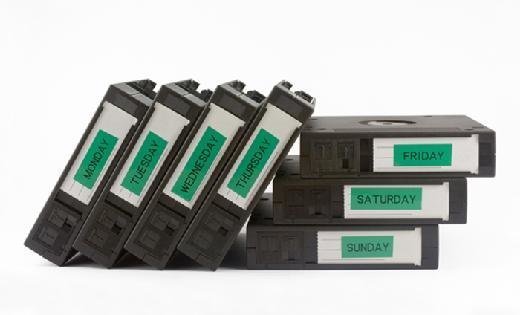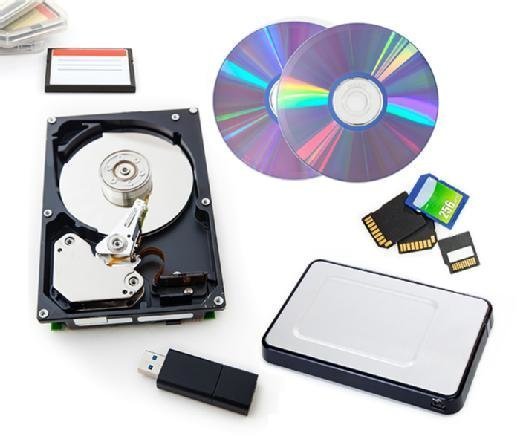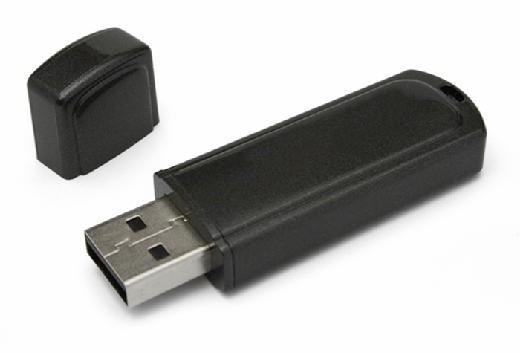Which Of The Following Is Typically Used For Large Data Backups Of Servers
A backup storage device is used to brand copies of information that is actively in use. Backup machines provide redundancy of data residing on master storage. Should the storage medium, such as a difficult disk bulldoze (HDD), fail or become corrupted, the original data is recovered from copies on the fill-in hardware. The use of fill-in storage is imperative in enterprise environments, where the loss of concern data is potentially catastrophic.
Backup storage devices for enterprise use
A backup storage device refers to a type of disk-based hardware appliance arranged with software for data management and data services. The physical device provides chapters via the internal storage media, while the backup software schedules policies for moving information in a tiered storage environment from primary storage to secondary storage -- also known equally auxiliary storage or external storage. Backup devices connect to storage using traditional NFS (Network File Organization) or iSCSI (Internet Small Figurer System Interface) network protocols.
A backup storage device is designated as a storage target for data copies, using replication and other data protection methods.
In an enterprise, backup storage is achieved through replication of data in multi-disk storage systems, such as RAID (redundant arrays of contained disks), or as part of a NAS (network-attached storage), SAN (storage area network) or tiered storage organisation. Enterprise fill-in storage often makes use of both disk and tape as storage media. Special software is used to manage backup as part of a storage arrangement.
The same means and media used for backup storage are ofttimes used for archival storage.
Remote backup appliances
A remote backup appliance backs up data that sits outside a corporate information center. When selecting an apparatus for remote fill-in, data storage administrators should counterbalance features for encryption, network connectivity and direction. Data deduplication and compression, which are offered with most remote backup appliances, reduce the amount of information sent across a network.
Remote backup appliances play an important role in an enterprise disaster recovery (DR) plan. Related use cases include business continuity, cold storage and data archiving for long-term retentiveness.
Virtual server backup
Virtual server backup is a software-based version of physical backup hardware. This practice involves copying information from a concrete machine to a virtual auto (VM) equally a safeguard against loss or corruption. The backup application is installed on each VM, pointing backups to a conventional backup storage target apparatus.
Physical disk backup devices: Disk-to-disk-to-tape storage
Enterprises apply backup storage devices to provide redundant copies of data that an system considers critical to sustained business concern operations. Such devices include dedicated backup hardware appliances and magnetic tape systems. Data deduplication systems contain HDDs and are equipped with software to set policies on backup and information reduction.
Modern information backup storage systems back up data at a block level, using software to keep track of only the information blocks inside a file that changed since the last full backup. This process, known every bit changed block tracking, sends just the inverse blocks to backup storage.
Most disk-based fill-in storage appliances enable copies to be moved from spinning media to magnetic tape storage for long-term retention. Disk-to-disk backup storage devices initially appeared as an alternative to magnetic storage with fill-in tape drive libraries. Magnetic tape systems are still used as backup media, due to increasing tape densities and the rise of linear tape file systems.
Disk-to-disk-to-tape is a strategy that copies data initially to a disk-based backup storage device. The same information is and then periodically written again from disk to tape. The deejay backup provides storage administrators with faster recovery than tape, while tape offers a more economic medium for long-term archiving and off-site storage.
Local backup for primary storage
Modernistic chief storage systems have evolved to feature stronger native capabilities for data backup. This includes advanced RAID protection schemes, unlimited snapshots and tools for replicating snapshots to secondary fill-in or fifty-fifty 3rd off-site backup. Despite these advances, chief storage-based backup tends to be more expensive and lacks the indexing capabilities found in traditional fill-in products.
Local backup places information copies on external HDDs or tape systems, typically housed in or virtually an on-premises data center. The information is transmitted over a secure high-bandwidth network connection or the corporate intranet.
Integrated backup storage appliances
Integrated information protection hardware is bachelor from sure vendors. An integrated device is a file server equipped with HDDs and the vendor's proprietary backup software, typically with automated features to assist monitor disk capacity, expand storage chapters and manage preconfigured tape libraries.
Cloud fill-in storage: Public, individual and hybrid
Cloud backup transmits information copies via a network to a remote location. The backup storage is hosted on servers owned past third-party cloud service providers that charge customers based on licensed consumption of bandwidth, storage chapters or number of users. Increasingly, off-site data backup equates to subscription-based cloud storage as a service, which provides low-cost, scalable capacity and eliminates a client's demand to buy and maintain fill-in hardware.
Cloud-to-cloud backup is an offshoot in which information is copied between multiple public cloud storage platforms. Using cloud-to-deject fill-in hastens recovery of mission-disquisitional data, although it likewise multiplies the chances that storage security could be compromised -- at to the lowest degree, in comparison to difficult offline fill-in.
Some enterprises opt to host internal private cloud storage using a proprietary network to back up data to locally managed servers. Others mix private cloud storage with internal private storage to build a hybrid cloud. Nonetheless it's deployed, cloud backup storage is cited by experts as a key ingredient in an enterprise disaster recovery strategy.
Varied backup storage media: Where practise backups go?
Regardless of where information technology resides, all backup storage at some betoken lands on stock-still disk. In the realm of backup storage, flash memory serves as an adjunct to disk-based systems. This architecture consists of a storage array outfitted with rotational disk drives mixed with solid-state drives (SSDs) that serve as flash cache. Data initially gets written to flash and after moved via software to disk for backup and other purposes.
Magnetic record is ane of the oldest backup storage device technologies, and despite the emergence of deject backup and loftier-capacity agile annal deejay storage, magnetic storage devices remain broadly used across several industries. Magnetic tape is suited for archiving due to its durability, high chapters and low cost, but the linear recording system isn't useful for random access. Tape archiving is designed as a long-term vault, significant online copies aren't available for quick retrieval. However, magnetic storage devices persist in enterprises due to increases in Linear Record-Open (LTO) densities, fueled by the release of the Linear Tape File Arrangement (LTFS).

NAS devices
A NAS device might variously be called a NAS filer, storage server filer, SAN filer or a storage filer. These file servers come with massive HDD storage capacity and often are earmarked for archiving, backup and shared storage, particularly in midsize organizations or those seeking to decrease their reliance on record. Calibration-out NAS devices have features that enable them to be used every bit an archiving tool for unstructured information.
A variant of physical NAS hardware is cloud NAS, which is unremarkably deployed for archive and backup. Cloud NAS overlaps with public cloud storage and operates in much the same style. The advantage of deject NAS is data accessibility from whatsoever place and at any time, although access speed depends on the network's data transfer charge per unit.

Object storage is gaining momentum as a tool to round out cloud-based data backup. Unlike file storage, information in object storage exists in a non-hierarchical format, with every object sharing the same flat address space. Object storage uses disk arrays to ingest large amounts of unstructured data to cloud storage for archiving, backup and data repositories.
Optical storage media refers to devices on which data is read or written by a light amplification by stimulated emission of radiation for archival and backup storage. Types of optical storage devices include Blu-Ray disk, CDs and DVDs. However, enterprise backup technology based on optical storage devices has lagged in the market place compared with other available backup media.

A virtual tape library (VTL) is an archival backup storage device that mimics the behavior of physical tape. Compared with a NAS device, a VTL provides better efficiency and performance to organizations running Fibre Channel (FC) networked storage. VTLs offer integrated data deduplication and write directly to disk. VTL advantages also include quicker backup and recovery and lower operating costs than some other backup methods.
Portable backup storage devices, storage at the edge
Several types of removable media are associated with fill-in storage devices, including cartridge-encrypted tape drives, optical media and USB (Universal Series Bus) drives. The main advantage of portable media is the power to move information from one computer to some other, although this creates the potential for security risks. Portable storage media tin evangelize the faster backup and recovery times needed in corporate SAN environments. By and large, removable media is more expensive than alternatives such as tape.
Portable storage oft is associated with backing up mobile computing devices used by field employees in remote role locations. Storage at the border is the practice of systematically backing up such devices that reside at the edge of corporate networks.

Backup storage devices for personal computers
On a personal estimator, fill-in storage is commonly accomplished with Nix drives and DVDs. A USB drive -- likewise known as a flash drive or keychain drive -- is a lightweight plug-and-play portable storage device that uses wink retentivity storage. The figurer'south Os (operating system) recognizes it as a removable drive when it's inserted into a USB port, upon which it'southward assigned a drive letter.

Several cloud backup vendors also offer consumer services. Companies such as Backblaze and Carbonite provide online backup for the domicile.
Cybersecurity and backup storage devices
Although at that place are many reasons why an system might need to use its backup storage device, protection confronting cyberattacks such as ransomware is increasingly of import. In the outcome of an attack, the arrangement can use the backup storage at its last known skillful point in fourth dimension to safely recover.
It'due south important to make sure the backup itself isn't compromised. Ransomware attackers have plant a way to infect backups, so organizations must be wary of restoring corrupted information.
Which Of The Following Is Typically Used For Large Data Backups Of Servers,
Source: https://www.techtarget.com/searchdatabackup/definition/backup-storage-device
Posted by: andujarhoucter.blogspot.com


0 Response to "Which Of The Following Is Typically Used For Large Data Backups Of Servers"
Post a Comment